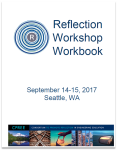By: Brook Sattler, PhD
CPREE multi-campus coordinator
In their journal article, “Educating effective engineering designers: the role of reflective practice,” Adams, Turns, and Atman (2003) characterize what contributes to effective engineering design education. They use Schön’s reflective practitioner theory to interpret verbal protocols of engineering students engaging in design activities; to do this, they explore these research questions:
1. How could we measure reflective practitioner behaviour in engineering students?
2. To what extent do engineering students behave as reflective practitioners?
3. In what ways are seniors more reflective practitioners than freshmen?
To start, they overview Schön’s reflective practitioner theory–“A reflective practitioner is a practitioner whose knowing is not only rational and cognitive but also embodied in action and for whom reflection is critical to practice” (Adams, Turns, & Atman, 2003, p. 276). In connecting this definition to engineering, specifically to engineering design, Adams, Turns, and Atman (2003) emphasize that “the designer functions as both a creator developing a solution and an experimenter trying to understand the situation he is creating, hence the notion of the designer as having a ‘reflective conversation’ with the situation” (p. 276). In their work, they focus on Schön’s reflection-in-action.
To explore their research questions, they identify measures of reflective practice behavior that are important features of effective design practice: problem setting and listening to ‘back talk.’ “Underlying these trends is a predicament typical of complex and ambiguous design tasks—information cannot be gathered meaningfully unless the problem is understood but you can’t understand the problem without gathering information about it. As Schön notes, a process of reflecting in action provides one means for filling this gap. It allows new requirements to emerge (and be synthesised) during solution development that cannot be adequately identified or pursued until portions of the system have been designed” (Adams, Turns, & Atman, 2003, p. 292).
Their work offers a foundational piece in bridging engineering education and reflection, specifically the use of Schön.
Citations
Adams, R. S., Turns, T., & Atman, C. A. (2003). Educating effective engineering designers: the role of reflective practice. Design Studies, 24(3), 275-294.
Schön D. 1983. The Reflective Practitioner. New York: Basic
Books.

